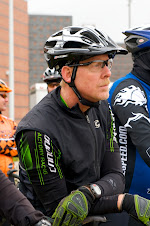
"Whereas, the athlete is a competitive cyclist who competes in competitive cycling events throughout the world."
I received my Cannondale sponsorship agreement in the mail on Monday. Ten pages of legalese and do's and dont's and expectations. A lot of it is similar to what we have used for the Cannondale Midwest Team in terms of expectations of the riders; behavior, use of product, number of races, confidentiality, etc.
There are a few clauses in there that I am going to get some clarification on to make sure I am in compliance and to help plan my schedule for next year. For instance, I didn't see anything in there about using the corporate plane to get me to some of those competitive events throughout the world.
It has been interesting to train using wattage instead of just heart rate. There is definitely a learning curve on my end to understand all the terms and interpreting the graphs and data available but the coach is an expert on it. While using power as a training tool has been around for awhile it has been used mainly by road racers. It is slowly catching on for the mtb racing community. Part of the reason thqt it's not as widely used by mountain bikers is the difficulty to use on a bike that has disc brakes. At least in an economical (an oxymoron term for power meters) sense.
While I can use my Power Meter on my 'cross bike, I purchased a steel framed 29" wheel mtb so that I can use the power wheel on there as well. I have the bike set up dimensionally as close to my racing bikes as possible. This should allow me to do some training and testing both on and off the road without losing too much of the feel for my regular bikes. Especially since most of my training will probably not be on my racing bikes.
Here is a good blog of someone who trains with power on a mtb. http://teamhealthfx.com/blogs/dave_harris/default.aspx
Probably the best source of info about using power http://www.cyclingpeakssoftware.com/power411/
I received my Cannondale sponsorship agreement in the mail on Monday. Ten pages of legalese and do's and dont's and expectations. A lot of it is similar to what we have used for the Cannondale Midwest Team in terms of expectations of the riders; behavior, use of product, number of races, confidentiality, etc.
There are a few clauses in there that I am going to get some clarification on to make sure I am in compliance and to help plan my schedule for next year. For instance, I didn't see anything in there about using the corporate plane to get me to some of those competitive events throughout the world.
It has been interesting to train using wattage instead of just heart rate. There is definitely a learning curve on my end to understand all the terms and interpreting the graphs and data available but the coach is an expert on it. While using power as a training tool has been around for awhile it has been used mainly by road racers. It is slowly catching on for the mtb racing community. Part of the reason thqt it's not as widely used by mountain bikers is the difficulty to use on a bike that has disc brakes. At least in an economical (an oxymoron term for power meters) sense.
While I can use my Power Meter on my 'cross bike, I purchased a steel framed 29" wheel mtb so that I can use the power wheel on there as well. I have the bike set up dimensionally as close to my racing bikes as possible. This should allow me to do some training and testing both on and off the road without losing too much of the feel for my regular bikes. Especially since most of my training will probably not be on my racing bikes.
Here is a good blog of someone who trains with power on a mtb. http://teamhealthfx.com/blogs/dave_harris/default.aspx
Probably the best source of info about using power http://www.cyclingpeakssoftware.com/power411/




No comments:
Post a Comment